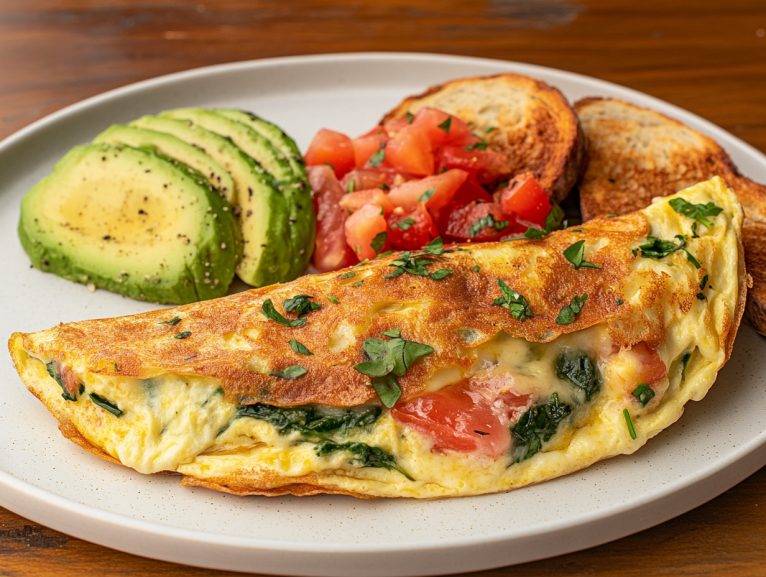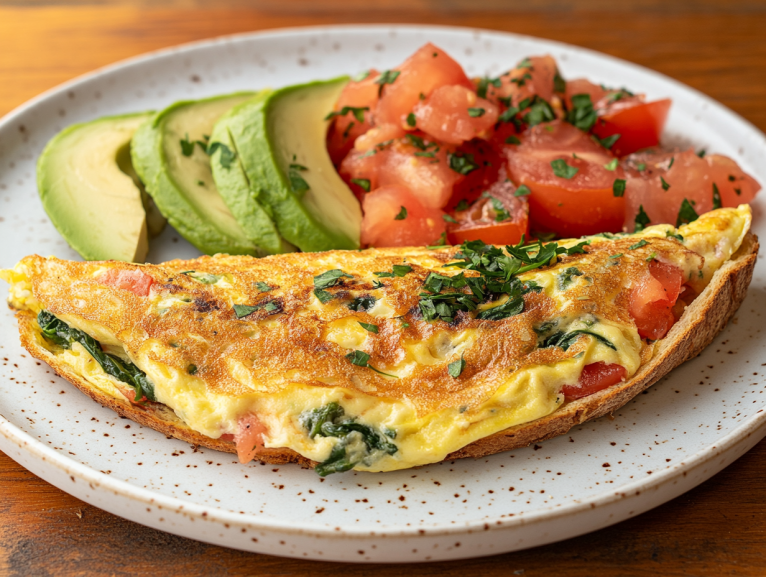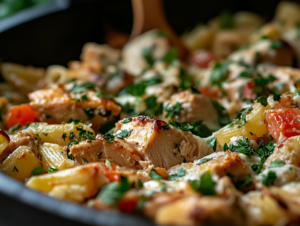
Omelette Recipe: Easy, Fluffy, and Customizable
Ingredients
Basic Ingredients:
- 3 large eggs
- 1 tablespoon butter or olive oil
- Salt and pepper (to taste)
Optional Fillings:
- Cheese: Cheddar, feta, mozzarella, or goat cheese (1-2 tablespoons)
- Vegetables: Diced bell peppers, onions, spinach, mushrooms, or tomatoes (1/4 cup)
- Meats: Cooked bacon, ham, or sausage (1-4 tablespoons)
- Herbs: Fresh parsley, chives, or cilantro (for garnish)
Feel free to mix and match fillings based on your preferences!
Instructions
- Prepare Your Ingredients:
-
- Crack the eggs into a bowl and whisk them until the yolks and whites are fully combined. Add a pinch of salt and pepper.
- Chop your chosen fillings (veggies, meats, etc.) into small, bite-sized pieces.
- Heat the Pan:
- Place a non-stick skillet over medium heat and add the butter or olive oil. Let it melt and coat the pan evenly.
- Cook the Eggs:
- Pour the whisked eggs into the pan. Let them cook undisturbed for about 20-30 seconds until the edges start to set.
- Add Fillings:
- Sprinkle your chosen fillings (cheese, veggies, meats) evenly over one half of the omelette.
- Fold and Serve:
- Using a spatula, gently fold the other half of the omelette over the fillings. Cook for another 30 seconds to melt the cheese and warm the fillings.
- Slide the omelette onto a plate, garnish with fresh herbs, and serve immediately.
Are you looking for a quick, delicious, and nutritious breakfast option? Look no further than the humble omelette! This versatile dish is a favorite for breakfast lovers worldwide, and for good reason. It’s easy to make, customizable, and packed with protein to keep you energized throughout the day. In this article, we’ll walk you through everything you need, including ingredients, step-by-step directions, nutritional information, and tips to elevate your omelette game.
The History of the Omelette: A Dish with Global Roots
The omelette has a rich history that spans cultures and continents. While its exact origins are debated, many believe it dates back to ancient Persia, where it was known as “kookoo,” a dish made with whipped eggs and herbs. The French later popularized it as we know it today, perfecting its light and fluffy texture. In fact, the word “omelette” comes from the French word “omelette,” which itself is derived from the Latin “lamella,” meaning “thin plate.” Over time, the omelette has evolved into countless regional variations, from the Spanish tortilla (a thick omelette with potatoes) to the Japanese tamagoyaki (a sweet, rolled omelette). This global appeal makes the omelette a truly universal dish, loved by people of all backgrounds.
Why Omelettes Are a Breakfast Favorite
Omelettes are a breakfast classic for several reasons:
- Quick and Easy: Ready in under 15 minutes, making them perfect for busy mornings.
- Customizable: Add your favorite veggies, cheeses, and meats to suit your taste.
- Nutritious: Packed with protein and essential nutrients to kickstart your day.
- Budget-Friendly: Requires only a few basic ingredients.
No wonder omelettes are a go-to breakfast option for so many!
Ingredients
Here’s what you’ll need to make a classic omelette (serves 1):
Basic Ingredients:
- 3 large eggs
- 1 tablespoon butter or olive oil
- Salt and pepper (to taste)
Optional Fillings:
- Cheese: Cheddar, feta, mozzarella, or goat cheese (1-2 tablespoons)
- Vegetables: Diced bell peppers, onions, spinach, mushrooms, or tomatoes (1/4 cup)
- Meats: Cooked bacon, ham, or sausage (1-4 tablespoons)
- Herbs: Fresh parsley, chives, or cilantro (for garnish)
Feel free to mix and match fillings based on your preferences!
Step-by-Step Directions
Follow these simple steps to create a restaurant-quality omelette at home:
- Prepare Your Ingredients:
- Crack the eggs into a bowl and whisk them until the yolks and whites are fully combined. Add a pinch of salt and pepper.
- Chop your chosen fillings (veggies, meats, etc.) into small, bite-sized pieces.
- Heat the Pan:
- Place a non-stick skillet over medium heat and add the butter or olive oil. Let it melt and coat the pan evenly.
- Cook the Eggs:
- Pour the whisked eggs into the pan. Let them cook undisturbed for about 20-30 seconds until the edges start to set.
- Add Fillings:
- Sprinkle your chosen fillings (cheese, veggies, meats) evenly over one half of the omelette.
- Fold and Serve:
- Using a spatula, gently fold the other half of the omelette over the fillings. Cook for another 30 seconds to melt the cheese and warm the fillings.
- Slide the omelette onto a plate, garnish with fresh herbs, and serve immediately.
Tips for Making the Perfect Omelette
- Use a Non-Stick Pan: This ensures your omelette doesn’t stick and makes flipping easier.
- Don’t Overcook: Keep the heat medium-low to avoid a rubbery texture. The eggs should be soft and slightly runny when you fold them.
- Whisk Well: Whisking the eggs thoroughly incorporates air, making your omelette light and fluffy.
- Experiment with Fillings: Try different combinations like spinach and feta, ham and cheddar, or mushrooms and Swiss cheese.
Nutritional Information
Omelettes are not only delicious but also highly nutritious. Here’s the nutritional breakdown for a basic 3-egg omelette (without fillings):
- Calories: 210 kcal
- Protein: 18g
- Fat: 15g
- Carbohydrates: 1g
- Fiber: 0g
- Sugar: 0g
Adding fillings like cheese, veggies, or meats will alter the nutritional profile, so adjust accordingly based on your ingredients.
Health Benefits
Omelettes aren’t just delicious—they’re also incredibly good for you! Eggs, the main ingredient, are a nutritional powerhouse. They’re packed with high-quality protein, which helps build and repair muscles, and contain essential vitamins like B12, D, and choline, which support brain health. Adding vegetables like spinach, tomatoes, or bell peppers boosts the fiber and antioxidant content, while cheese provides calcium for strong bones. For those watching their calorie intake, egg whites can be used instead of whole eggs to reduce fat and cholesterol. With the right ingredients, an omelette can be a balanced meal that fuels your body and keeps you satisfied for hours.
Customizing Your Omelette
One of the best things about omelettes is how incredibly customizable they are, making them perfect for any palate or dietary preference. For a vegetarian omelette, try combining fresh spinach, juicy tomatoes, diced onions, and crumbled feta cheese for a flavorful, nutrient-packed meal that comes in at around 250 calories. If you’re a meat lover, load up your omelette with savory fillings like ham, crispy bacon, sausage, and a generous sprinkle of cheddar cheese for a hearty option that’s roughly 350 calories. Cheese enthusiasts can indulge in a cheese lover’s omelette by mixing mozzarella, cheddar, and creamy goat cheese, creating a rich and gooey delight that’s about 300 calories. For those watching their carb intake, a low-carb omelette with earthy mushrooms, tender spinach, and creamy avocado is a delicious and satisfying choice, clocking in at around 220 calories.
Common Mistakes to Avoid
Even though omelettes are simple to make, there are a few common pitfalls to watch out for. One mistake is overcooking the eggs, which can result in a dry, rubbery texture. To avoid this, cook the omelette on medium-low heat and remove it from the pan while it’s still slightly runny—it will continue to cook from residual heat. Another mistake is overloading the omelette with too many fillings, which can make it difficult to fold and cause it to fall apart. Stick to a handful of ingredients for the best results. Lastly, avoid stirring the eggs too much once they’re in the pan; let them set slightly before adding fillings and folding.
Serving Suggestions:
While an omelette is delicious on its own, pairing it with the right sides can take your meal to the next level. For a classic breakfast, serve your it with toast, hash browns, or fresh fruit. If you’re in the mood for something savory, try pairing it with avocado slices, smoked salmon, or a side salad. For a heartier meal, add a slice of crusty bread or a bowl of soup. And don’t forget the beverages—a cup of coffee, orange juice, or herbal tea complements the flavors of an omelette perfectly. With so many options, you can create a meal that’s as unique as your omelette!
Frequently Asked Questions (FAQs)
1. Can I make an omelette without milk?
Yes! Milk is not necessary for an omelette. Whisking the eggs well is enough to create a fluffy texture.
2. How do I prevent my omelette from sticking to the pan?
Use a non-stick pan and enough butter or oil to coat the surface evenly.
3. Can I make an omelette ahead of time?
While omelettes are best served fresh, you can prepare the fillings ahead of time to save time in the morning.
4. What’s the difference between an omelette and a frittata?
An omelette is cooked quickly on the stovetop and folded, while a frittata is baked in the oven and served open-faced.
Conclusion
Mastering the art of making the perfect omelette is a skill that will serve you well for years to come. Whether you prefer a classic cheese omelette or a loaded veggie-packed version, this dish is sure to satisfy your taste buds and keep you full until lunch.
So, the next time you’re wondering what to make for breakfast, grab your eggs and get cracking! With this guide, you’ll be whipping up delicious omelettes like a pro in no time.





